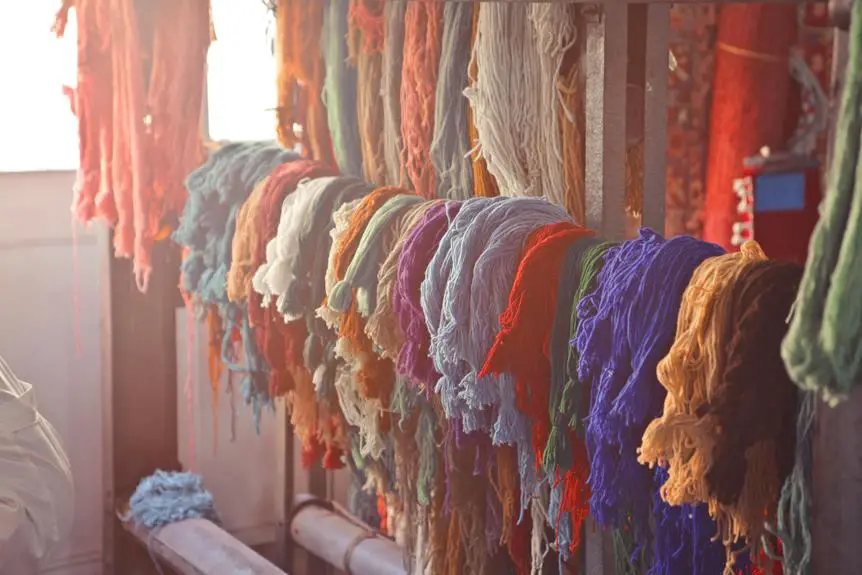If you're looking to explore the art of embroidery, starting with the right tools and techniques is essential. You'll want to gather items like an embroidery hoop, needles, and quality threads, while choosing a lightweight fabric like cotton can make your initial projects easier. As you prepare your design and practice basic stitches, you'll discover how patience and precision can transform simple materials into beautiful creations. But before you get started, it's important to understand some key elements that can make or break your embroidery experience.
Table of Contents
Key Takeaways
- Choose lightweight fabrics like cotton or linen for beginners, ensuring ease of handling and stitching.
- Use a sturdy embroidery hoop to keep fabric taut, which aids in precise stitching.
- Select the appropriate threads and needles; larger-eyed needles accommodate thicker threads for varied effects.
- Prepare your design by transferring it clearly onto the fabric for accurate stitching.
Essential Tools for Embroidery
To get started with embroidery, you'll need a few essential tools that make the process smoother and more enjoyable.
First off, grab a sturdy embroidery hoop. It keeps your fabric taut, making it easier to stitch without puckering. Next, choose the right needles; embroidery needles with a larger eye accommodate thicker threads, ensuring a seamless experience.
You'll also want a selection of embroidery threads. Cotton floss is popular, but you can explore other types, like wool or silk, depending on your project. Don't forget scissors! A small, sharp pair will help you snip threads cleanly and precisely.
You'll benefit from having fabric marking tools on hand, too. Disappearing ink pens or chalk pencils allow you to trace your designs without leaving permanent marks. Lastly, consider having a small storage container for your tools. Keeping everything organized will save you time and frustration as you work.
With these essential tools, you're well on your way to creating beautiful embroidered pieces. So gather your supplies, and get ready to unleash your creativity!
Basic Stitch Techniques
Mastering basic stitch techniques is essential for bringing your embroidery designs to life. These foundational skills won't only enhance your creativity but also improve the overall quality of your work.
Here are three essential stitches you should get comfortable with:
- Backstitch: This stitch creates a solid line and is perfect for outlining your designs. It's simple and provides a clean finish.
- Satin Stitch: Ideal for filling in shapes, the satin stitch gives a smooth, polished appearance. Practice this stitch to achieve vibrant, full areas of color.
As you practice these stitches, make sure to maintain consistent tension and keep your fabric taut. Experiment with different colors and thread types to see how they affect your designs.
Choosing the Right Fabric
Selecting the right fabric is crucial for achieving the best results in your embroidery projects. When you choose your fabric, consider its weight, texture, and composition.
Lightweight fabrics like cotton or linen work well for beginners because they're easy to handle and provide a smooth surface for stitching. Heavier fabrics, such as denim or canvas, can be more challenging but offer a sturdy base for intricate designs.
Think about the type of embroidery you plan to do. If you're working with delicate stitches, opt for a tightly woven fabric that won't fray easily. For bold, thick threads, you might prefer a coarser material that can support the weight.
Also, keep in mind the fabric's color. Lighter colors tend to show off bright threads better, while darker fabrics can produce a striking contrast.
Before diving into your project, always test a small piece of fabric with your chosen thread and stitch type. This way, you'll ensure your combination works harmoniously together.
Preparing Your Design
After you've chosen the right fabric, the next step is to prepare your design for embroidery. This process involves selecting your design, adjusting it to fit your fabric, and ensuring it's ready for stitching.
Here's how to get started:
- Select Your Design: Choose a design that resonates with you. Whether it's a pattern, text, or an image, make sure it's something you'll enjoy working on.
- Size and Placement: Scale your design to fit your fabric appropriately. You want it to be centered and proportionate, so consider using software or a projector to visualize where it will sit.
Once you've completed these steps, you'll have a solid foundation for starting your embroidery project.
Preparing your design thoughtfully sets the stage for a successful outcome, so take your time and get it right!
Tips for Successful Embroidery
To achieve beautiful results in embroidery, focus on maintaining consistent tension in your thread as you stitch. This helps create even stitches and prevents puckering. Additionally, consider the following tips to enhance your embroidery experience:
| Tip | Description |
|---|---|
| Choose the right fabric | Use a fabric that's suitable for your design and thread. |
| Use quality thread | Invest in good thread to ensure durability and colorfastness. |
| Keep your workspace tidy | A clean area minimizes distractions and makes stitching easier. |
| Practice different stitches | Familiarize yourself with various stitches to add texture and interest. |
| Take breaks | Step away occasionally to prevent fatigue and maintain focus. |
Frequently Asked Questions
Can I Use Any Type of Thread for Embroidery?
You can't just use any thread for embroidery. It's best to choose threads specifically designed for it, like cotton or rayon. These threads provide better durability and appearance, ensuring your designs look their best.
How Do I Fix Mistakes in My Embroidery?
If you make mistakes in your embroidery, don't worry! You can carefully unpick the stitches with a seam ripper, or cover errors creatively with additional stitches or embellishments to enhance your design.
Is Embroidery Machine or Hand Embroidery Better for Beginners?
For beginners, hand embroidery's simplicity and tactile nature can be more accessible. However, if you want speed and precision, an embroidery machine might suit you better. Consider your goals and personal enjoyment when choosing.
How Do I Care for Embroidered Fabric?
To care for embroidered fabric, you should wash it gently by hand or on a delicate cycle. Avoid harsh detergents, and let it air dry. Iron it on low heat, using a cloth to protect the design.
Can I Embroider on Stretchy Fabrics Like T-Shirts?
Yes, you can embroider on stretchy fabrics like t-shirts. Just use a stabilizer to prevent distortion and choose the right needle and thread to ensure your design stays intact while the fabric stretches.
- Tetron Fabric for Marine Applications: Durability and Use Cases - June 18, 2025
- Tetron Fabric for Outdoor Furniture: Weather Resistance and Care - June 18, 2025
- Tetron Fabric for Wall Coverings: Style and Application Tips - June 18, 2025



